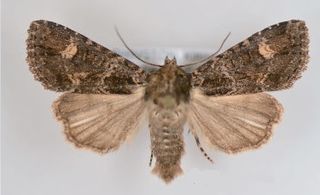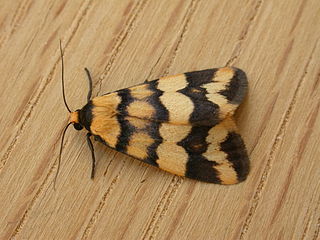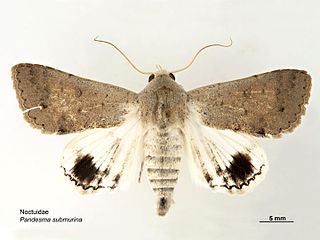
Mythimna separata, the northern armyworm, oriental armyworm or rice ear-cutting caterpillar, is a moth of the family Noctuidae. It is found in China, Japan, South-east Asia, India, eastern Australia, New Zealand, and some Pacific islands. It is one of the major pests of maize in Asia. The species was first described by Francis Walker in 1865.

Termessa nivosa is a moth of the subfamily Arctiinae first described by Francis Walker in 1865. It is found in the Australian states of New South Wales, South Australia and Victoria.

Termessa is a genus of moths in the subfamily Arctiinae The genus was described by Newman in 1856.

Ichneutica insignis is a moth of the family Noctuidae. It is endemic to New Zealand. This species is found throughout New Zealand, although it appears to be scarce in inland sites of tussock grasslands. The adults are on the wing throughout the year. It is a variable species and as such can be easily confused with I. skelloni and I. plena. The larvae of this species have been recorded as feeding on Trifolium pratense.

Aseptis binotata, the rusty shoulder knot moth, is a moth of the family Noctuidae. The species was first described by Francis Walker in 1865. It is found widespread in western North America, west of south-central Alberta, Wyoming, and Nebraska. Along the Pacific Coast it occurs from northern Mexico to south-central British Columbia. It can be found from sea level to altitudes over 2000 meters in a variety of habitats from dense forest to shrub desert.

Condica dolorosa is a moth of the family Noctuidae. It is found in the Indo-Australian tropics, including Borneo, Hawaii, Hong Kong, India, Sri Lanka, Taiwan and Queensland in Australia.

Pinara metaphaea, the pinara moth, is a species of moth of the family Lasiocampidae. It was first described by Francis Walker in 1862. It is known from south-east Australia, including New South Wales and Victoria.

Termessa zonophanes, the double yellow-patched footman, is a moth of the subfamily Arctiinae. The species was first described by Edward Meyrick in 1888. It is known from the Australian Capital Territory, New South Wales, Queensland and Victoria.

Zalissa catocalina is a moth of the family Noctuidae first described by Francis Walker in 1865. It is found in Papua New Guinea and Australia. In Australia, it is found in or near rainforests in eastern Australia as far south as northern New South Wales.

Armactica columbina is a moth of the family Nolidae first described by Francis Walker in 1865. It is found in the Australian states of New South Wales, Queensland and the north of Western Australia.

Pandesma submurina, the pale migrant, is a moth of the family Erebidae first described by Francis Walker in 1865. It is found in Australia in New South Wales, the Northern Territory, Queensland and Western Australia.

Dumbletonius characterifer is a species of moth of the family Hepialidae. It is endemic to New Zealand. It was first described by Francis Walker in 1865.

Declana atronivea, commonly called the North Island lichen or North Island zebra moth, is a moth of the family Geometridae. It is endemic to New Zealand. It is one of only two insect species with asymmetrical wing markings.
Schistophleps albida is a moth in the family Erebidae. It was described by Francis Walker in 1864. It is found in Australia and New Guinea.
Termessa catocalina is a moth in the subfamily Arctiinae. It was described by Francis Walker in 1865. It is found in Australia, where it has been recorded from New South Wales and Victoria.
Termessa congrua is a moth in the subfamily Arctiinae. It was described by Francis Walker in 1865. It is found in Australia, where it has been recorded from New South Wales and Queensland.
Termessa discrepans is a moth in the subfamily Arctiinae. It was described by Francis Walker in 1865. It is found in Australia, where it has been recorded from the Australian Capital Territory, New South Wales, Queensland and Victoria.
Termessa laeta is a moth in the subfamily Arctiinae. It was described by Francis Walker in 1856. It is found in Australia, where it has been recorded from the Australian Capital Territory, New South Wales, Queensland, South Australia, Victoria and Western Australia.
Tigrioides nitens is a moth in the family Erebidae. It was described by Francis Walker in 1865. It is found in Australia, where it has been recorded from New South Wales, the Northern Territory and Queensland.











